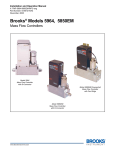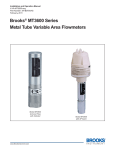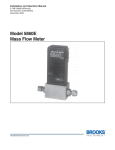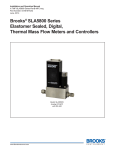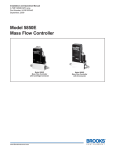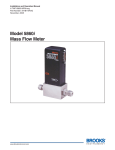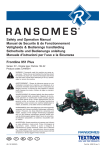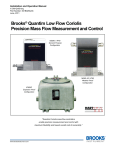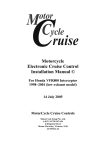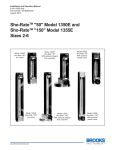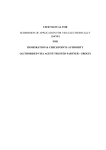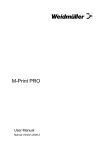Download Brooks Instrument SLA7900 User Manual
Transcript
Installation and Operation Manual X-TMF-SLA7900-MFC-eng Part Number: 541B022AAG August, 2009 SLA7900 Series Brooks® Models SLA7950 - SLA7960 Mass Flow Controllers & Meters Model SLA7950S Analog I/O 9-pin D-Connector VCR Fittings Model SLA7950S Analog I/O 15-pin D-Connector VCR Fittings Model SLA7950D Digital I/O DeviceNet Downport SLA7900 Series Installation and Operation Manual X-TMF-SLA7900-MFC-eng Part Number: 541B022AAG August, 2009 Essential Instructions Read this page before proceeding! Brooks Instrument designs, manufactures and tests its products to meet many national and international standards. Because these instruments are sophisticated technical products, you must properly install, use and maintain them to ensure they continue to operate within their normal specifications. The following instructions must be adhered to and integrated into your safety program when installing, using and maintaining Brooks Products. • Read all instructions prior to installing, operating and servicing the product. If this instruction manual is not the correct manual, please see back cover for local sales office contact information. Save this instruction manual for future reference. • If you do not understand any of the instructions, contact your Brooks Instrument representative for clarification. • Follow all warnings, cautions and instructions marked on and supplied with the product. • Inform and educate your personnel in the proper installation, operation and maintenance of the product. • Install your equipment as specified in the installation instructions of the appropriate instruction manual and per applicable local and national codes. Connect all products to the proper electrical and pressure sources. • To ensure proper performance, use qualified personnel to install, operate, update, program and maintain the product. • When replacement parts are required, ensure that qualified people use replacement parts specified by Brooks Instrument. Unauthorized parts and procedures can affect the product's performance and place the safe operation of your process at risk. Look-alike substitutions may result in fire, electrical hazards or improper operation. • Ensure that all equipment doors are closed and protective covers are in place, except when maintenance is being performed by qualified persons, to prevent electrical shock and personal injury. Pressure Equipment Directive (PED) All pressure equipment with an internal pressure greater than 0.5 bar (g) and a size larger than 25mm or 1" (inch) falls under the Pressure Equipment Directive (PED). The Directive is applicable within the European Economic Area (EU plus Norway, Iceland and Liechtenstein). Pressure equipment can be traded freely within this area once the PED has been complied with. • Section 1 of this manual contains important safety and operating instructions related to the PED directive. • Meters described in this manual are in compliance with EN directive 97/23/EC module H Conformity Assessment. • All Brooks Instrument Flowmeters fall under fluid group 1. • Meters larger than 25mm or 1" (inch) are in compliance with category I, II, III of PED. • Meters of 25mm or 1" (inch) or smaller are Sound Engineering Practice (SEP). ESD (Electrostatic Discharge) Handling Procedure: 1. Power to unit must be removed. 2. Personnel must be grounded, via a wrist strap or other safe, suitable means before any printed circuit card or other internal device is installed, removed or adjusted. 3. Printed circuit cards must be transported in a conductive container. Boards must not be removed from protective enclosure until immediately before installation. Removed boards must immediately be placed in protective container for transport, storage or return to factory. Comments This instrument is not unique in its content of ESD (electrostatic discharge) sensitive components. Most modern electronic designs contain components that utilize metal oxide technology (NMOS, SMOS, etc.). Experience has proven that even small amounts of static electricity can damage or destroy these devices. Damaged components, even though they appear to function properly, exhibit early failure. Installation and Operation Manual X-TMF-SLA7900-MFC-eng Part Number: 541B022AAG August, 2009 SLA7900 Series Dear Customer, We appreciate this opportunity to service your flow measurement and control requirements with a Brooks Instrument device. Every day, flow customers all over the world turn to Brooks Instrument for solutions to their gas and liquid low-flow applications. Brooks provides an array of flow measurement and control products for various industries from biopharmaceuticals, oil and gas, fuel cell research and chemicals, to medical devices, analytical instrumentation, semiconductor manufacturing, and more. The Brooks product you have just received is of the highest quality available, offering superior performance, reliability and value to the user. It is designed with the ever changing process conditions, accuracy requirements and hostile process environments in mind to provide you with a lifetime of dependable service. We recommend that you read this manual in its entirety. Should you require any additional information concerning Brooks products and services, please contact your local Brooks Sales and Service Office listed on the back cover of this manual or visit www.BrooksInstrument.com Yours sincerely, Brooks Instrument Installation and Operation Manual X-TMF-SLA7900-MFC-eng Part Number: 541B022AAG August, 2009 SLA7900 Series THIS PAGE WAS INTENTIONALLY LEFT BLANK Installation and Operation Manual X-TMF-SLA7900-MFC-eng Part Number: 541B022AAG August, 2009 Paragraph Number Contents SLA7900 Series Page Number Section 1 Introduction 1-1 Scope ............................................................................................................................................... 1-1 1-2 Purpose ............................................................................................................................................ 1-1 1-3 Description ....................................................................................................................................... 1-1 1-4 Specifications ................................................................................................................................... 1-2 Section 2 Installation 2-1 General ............................................................................................................................................. 2-1 2-2 Receipt of Equipment ....................................................................................................................... 2-1 2-3 Recommended Storage Practice ...................................................................................................... 2-1 2-4 Return Shipment .............................................................................................................................. 2-2 2-5 Transit Precautions .......................................................................................................................... 2-2 2-6 Removal from Storage ...................................................................................................................... 2-2 2-7 Gas Connections .............................................................................................................................. 2-3 2-8 In-Line Filter ..................................................................................................................................... 2-3 2-9 Installation ........................................................................................................................................ 2-3 2-10 Electrical Interface (Analog I/O) ....................................................................................................... 2-5 2-11 Operation Check Procedure (Analog I/O) ........................................................................................ 2-9 2-12 Electrical Interface (DeviceNet I/O) ................................................................................................. 2-10 2-13 Operation Check Procedure (DeviceNet I/O) .................................................................................. 2-11 2-14 DeviceNet Features ......................................................................................................................... 2-11 Section 3 Operation 3-1 General ............................................................................................................................................. 3-1 3-2 Theory of Operation for Flow Measurement ..................................................................................... 3-1 3-3 Features ........................................................................................................................................... 3-2 3-4 Adaptive Valve Control ..................................................................................................................... 3-3 3-5 Analog Mode of Operation ................................................................................................................ 3-3 Section 4 Maintenance & Troubleshooting 4-1 Overview .......................................................................................................................................... 4-1 4-2 Troubleshooting ................................................................................................................................ 4-2 4-3 Gas Conversion Factors ................................................................................................................... 4-5 4-4 Orifice Sizing .................................................................................................................................... 4-7 4-5 Restrictor Sizing ............................................................................................................................... 4-7 Section A CE Certification CE Certification of Mass Flow Equipment ........................................................................................ A-1 Section B Zero Drift Diagnostic on SLA7950S .................................................................................................. B-1 Warranty, Local Sales/Service Contact Information ....................................................................... Back Cover i Contents SLA7900 Series Installation and Operation Manual X-TMF-SLA7900-MFC-eng Part Number: 541B022AAG August, 2009 Figures Figure Page Number Number 1-1 General Wiring ................................................................................................................................. 1-5 1-2 Model SLA7950S MFC Analog I/O 9-pin D-Connector with VCR Fittings. ....................................... 1-7 1-3 Model SLA7950S MFC Analog I/O 9-pin D-Connector with Downport Connections(C-seal) ........... 1-7 1-4 Model SLA7950S MFC Analog I/O 15-pin D-Connector with VCR Fittings. ..................................... 1-8 1-5 Model SLA7950S MFC Analog I/O 15-pin D-Connector with Downport Connections(C-seal) ......... 1-8 1-6 Model SLA7950D MFC DeviceNet Digital I/O with Downport Connections(C-seal) ......................... 1-9 1-7 Model SLA7950D MFC DeviceNet Digital I/O with VCR Fittings. ..................................................... 1-9 1-8 Model SLA7950S MFC 15-pin D-Connector Analog with 1.5" Downport Connections (W-seal) ..... 1-10 2-1 2-2 2-3 2-4 2-5 2-6 2-7 15-pin D-Connector Shielded Cable Hookup Diagram Voltage I/O Version ..................................... 2-6 Common Electrical Hookups for 15-pin D-Connector Voltage I/O Version ....................................... 2-6 Recommended Wiring Configuration for Current Signals (Non-Isolated Power Supply) .................. 2-7 Recommended Wiring Configuration for Current Signals (Isolated Power Supply) ......................... 2-7 9-in D-Connector Shielded Cable Hookup Diagram Voltage I/O Version ......................................... 2-8 Common Electrical Hookups for 9-pin D-Connector Voltage I/O Version ......................................... 2-8 5-in Shielded Cable Hookup Diagram Voltage I/O Version .............................................................. 2-10 3-1 3-2 3-3 Flow Sensor Operational Diagram ................................................................................................... 3-2 Externally Accessible Adjustment ..................................................................................................... 3-4 Flow Control System Block Diagram ................................................................................................ 3-5 4-1 Bench Troubleshooting Circuit ......................................................................................................... 4-6 B-1 B-2 B-3 B-4 B-5 Recommended Shutoff Valve Configuration ..................................................................................... B-1 ZDD Interlock Timing ........................................................................................................................ B-2 Error Limits ....................................................................................................................................... B-3 Connecting to the SLA7950S Service Port ....................................................................................... B-4 About ZDDCT Window ..................................................................................................................... B-5 Tables Table Page Number Number 1-1 PED Rating ....................................................................................................................................... 1-3 ii 2-1 Recommended Filter Size ................................................................................................................ 2-3 4-1 4-2 4-3 Sensor Troubleshooting ................................................................................................................... 4-5 Orifice Capacities ............................................................................................................................. 4-7 Model SLA7900 Series Standard Restrictors ................................................................................... 4-8 Section 1 Introduction Installation and Operation Manual X-TMF-SLA7900-MFC-eng Part Number: 541B022AAG August, 2009 SLA7900 Series 1-1 Scope Thank you for purchasing a Brooks Instrument SLA7900 Series device. This manual Part Number 541B022AHG is a complete installation and operation manual for your device. 1-2 Purpose The Brooks® SLA7900 Series are mass flow measurement devices designed for accurately measuring and rapidly controlling flows of gases. This instruction manual is intended to provide the user with all the information necessary to install, operate and maintain the Brooks SLA7900 Series devices. This manual is organized into the following sections: Section 1 Section 2 Section 3 Section 4 Section A Section B Back Cover Introduction Installation Operation Maintenance & Troubleshooting CE Certification Zero Drift Diagnostic on SLA7950S Warranty, Local Sales/Service Contact Information It is recommended that this manual be read in its entirety before attempting to operate or repair the Brooks SLA7900 Series devices. 1-3 Description Brooks Instrument’s SLA7900 Series is a 1.125” wide profile high purity metal sealed thermal mass flow measurement and control instrument, which offers unparalleled flexibility and performance. The SLA7900 Series MFC is designed for use in advanced gas handling systems. The result is the most accurate, repeatable, and responsive MFC on the market today! Superior Valve Technology The coplanar valve offers unmatched performance. Due to its simplified construction, the valve exhibits superior repeatability, stability, and response time. Highly Adaptable Configurations The 1.125” body offers a compact, space saving footprint. The SLA7900 Series is easily retrofitable to existing gas box designs that utilize the traditional 1.5” MFC body platform. Likewise, the all-digital electronics is adaptable and allows the SLA7900 Series to serve as a direct replacement for existing analog products bringing with them greatly improved accuracy and reliability. Broad Array of Communication Options Brooks offers traditional 0-5 volt and 4-20 mA analog options as well as RS-485 digital communications (“S-protocol”, based on HART). Brooks also offers control interface with DeviceNetTM, a high-speed (up to 500k baud) digital communication network. Brooks’ communication capabilities and device-profiles have been certified by the ODVATM (Open DeviceNet Vendor’s Association). Other network protocols are in development. Talk to your Brooks representative about your specific needs. 1-1 Section 1 Introduction Installation and Operation Manual X-TMF-SLA7900-MFC-eng Part Number: 541B022AAG August, 2009 SLA7900 Series Reduced Cost of Ownership The SLA7900 Series allows multi-gas and multi-range capabilities to reduce customer inventory. Storage and pre-programming of up to 10 gas calibrations easily permits users to switch between different gases and ranges on a single device. Also, the greater control range provided by the coplanar valve gives users the option to decrease the number of parts needed to control their entire process. either analog or digital modes, reducing measurement errors resulting from property differences between process gases and the calibration gas. Zero Drift Diagnostic Option The Zero Drift Diagnostic is an advanced diagnostic now offered on the 7950S MFC and 7960S MFM, which detects and alerts the user when the flow sensor zero drifts by more than user specified limits. This unique feature monitors the flow signal during no-flow conditions and then utilizes the alarms to notify the user when an out of limits condition has been detected. Zero drift can be accurately detected because Brooks MFCs have the ability to monitor both positive and negative flow signals. This diagnostic gives the user a higher level of confidence that the process has not shifted. Brooks products have long been revered for their resistance to zero drift over long periods of time. Now Brooks is the first MFC supplier to prove their stability. 1-4 Specifications WARNING Do not operate this instrument in excess of the specifications listed below. Failure to heed this warning can result in serious personal injury and/or damage to the equipment. PERFORMANCE CHARACTERISTICS: Flow Ranges Models SLA7950/SLA7960 Any range from 0-3 sccm to 0-50 slpm N2 eq.* Control Range Turndown 100:1 (for any FS range from 1-50 slpm) Turndown 50:1 (for FS range below 1 slpm) Accuracy ±1.0% of rate, including linearity (20% to 100% F.S.), ±0.2% of F.S. (below 20% full scale.) Repeatability ±0.20% of rate Settling Time < 1 sec for all step changes above 5% FS** 1-2 Temperature Sensitivity Zero: Less than 0.035% F.S. per °C Span: Less than 0.1% of rate per °C Section 1 Introduction Installation and Operation Manual X-TMF-SLA7900-MFC-eng Part Number: 541B022AAG August, 2009 SLA7900 Series RATINGS: Pressure Equipment Directive (PED) 97/23/EC See Table 1 Table 1 PED Rating Mass Flow Controller Flow Ranges N2 Equivalent Ratings Models Min. f.s. Max f.s. SLA7950/ 3.0 50,000 SLA7960 Unit sccm Pressure PED Module H Category Bar 100 Bar SEP Mounting Attitude Sensitivity 0.2% of FS maximum deviation after rezeroing Valve Leak-By: < 0.5% F.S. Leak Integrity Inboard to Outboard: less than 1x10-10 atm scc/sec Helium max. Ambient Temperature Limits Operating: 0°C to 65°C (32°F to 149°F) Non-Operating: -25°C to 100°C (-13°F to 212°F) Maximum Operating Pressure Range 1500 psig (10,342 kPa) maximum 150 psig (106.2 kPa) and below recommended for best performance. Differential Pressure Range 5 - 50 psid (broader depending on customer conditions; consult factory for details.)*** (34.5 - 344.7 kPa) (259 - 2586 torr) Particulate Zero particles per cubic foot greater than 0.1 microns under process conditions. Less than 4 particles per cubic foot greater than 0.02 microns under process conditions. PHYSICAL: Materials of Construction 316L Vacuum Arc Remelt (VAR), 316L and high-alloy ferritic stainless steel. External/internal seals: Nickel Valve seat: 17-7PH stainless steel - standard Process Connections Integral 1/4" male VCRTM CS Seal (SEMI 2787.5 or SEMI F82-0304 R1-1) C Seal (SEMI 2787.1 or SEMI F82-0304 R1-2) W Seal (SEMI 2787.3 or SEMI F82-0304 R1-3) 1-3 Section 1 Introduction Installation and Operation Manual X-TMF-SLA7900-MFC-eng Part Number: 541B022AAG August, 2009 SLA7900 Series Outline Dimensions Refer to Figures 1-1 through 1-7Electrical Characteristics: Electrical Connections Analog I/O option: 9-pin D-connector or 15-pin D-Connector, male DeviceNet I/O option: 5-pin Micro-Connector, male RS-485 option: 15-pin D-Connector, male Analog I/O Pin Connections for 9-pin D-Connector: Function 9-pin D-conn Override, Input Flow Signal, 0-5 volt, Output (+) Power Supply, +13.5 Vdc to +27 Vdc (+) Power Supply, Common (-) Not Connected Setpoint, 0-5 Vdc, Input (+) Flow Signal, Common Output, (-) Setpoint, Command Input (-) Not Connected Valve 1 2 3 4 5 6 7 8 9 Analog I/O Pin Connections for 15-pin D-Connector: Function Setpoint, Common Input (-) Flow Signal, 0(1)-5 volt, Output (+) TTL Alarm, open collector, Output (+) Flow Signal, 0(4)-20 mA, Output (+) Power Supply, +13.5 Vdc to +27 Vdc(+) Not Connected Setpoint, 0(4)-20 mA, Input (+) Setpoint, 0(1)-5 Vdc, Input (+) Power Supply, Common (-) Flow Signal, Common, Output, (-) Reference, +5 Vdc, Output (+) Valve Override, Input Calibration Select, Input RS-485 Common B (-) RS-485 Common A (+) 15-pin D-Conn 1 2 3 4 5 6 7 8 9 10 11 12 13 14 15 Power Supply Voltage Watts typ. Analog I/O or RS-485 option, with valve: VIN = 27 Vdc Valve = Full Open DeviceNet I/O option, with valve: VIN = 25 Vdc Valve = Full Open Watts Max. 4.2 4.6 6.3 6.9 * Standard temperature and pressure are in accordance with SEMI Standard E12-96: 0°C and 101.32 kPa (760 torr) ** Within ±2% of rate or ±0.5% FS, which ever is greater, per SEMI E17-91 ***For flows above 30 slpm N2 eq., 30 psid minimum required 1-4 Installation and Operation Manual X-TMF-SLA7900-MFC-eng Part Number: 541B022AAG August, 2009 Section 1 Introduction SLA7900 Series RS-485 Communications The Brooks Digital Series is equipped with RS-485 communication capability. Refer to Table 1-3 (Analog I/O pin connections), that enables the device to communicate via a personal computer for process control. Baud rate selections for the Brooks Digital Series related to RS-485 are: 1200, 2400, 4800, 9600, 19200 and 38400 baud and can be selected via the Brooks Service SuiteTM. The RS-485 is essentially a multi-drop connection. It allows a maximum of 32 devices to be connected to a computer system. IBM-compatible PC’s are not equipped with RS-485 ports as standard. An RS-232 to RS-485 converter or RS-485 interface board is therefore required to connect an RS-485 network to a standard pc. The RS-485 bus, a daisy chain network, meaning that the wires are connected at the units as in Figure 1-1. This form of multi-drop capable communication provides access to many of the Brooks Digital Series functions for “control and monitor” operations, including: • Accurate setpoint adjustment and flow output measurement (including units of measure selection) • Valve Override (controller only) • Flow Totalizer • Alarm status and settings • Soft Start Control (controller only) Reference the Brooks document “S-protocol Communication Command Description for Smart II” for more details regarding the capabilities of the RS-485 communication interface. Figure 1-1 General Wiring 1-5 Section 1 Introduction SLA7900 Series Installation and Operation Manual X-TMF-SLA7900-MFC-eng Part Number: 541B022AAG August, 2009 DeviceNet Communications The Brooks Digital Series is also available with DeviceNet communication capability. DeviceNet is an open digital protocol capable of high speeds and easy system connectivity. Brooks Instrument has several of its devices available on this popular networking standard, and is a member of ODVA (Open DeviceNet Vendors Association), the governing standard body for DeviceNet. DeviceNet is similar to the RS485 standard in that it is a multi-drop connection that allows a maximum of 64 devices to be connected on the same network. Baud rate selections for DeviceNet products are 125K, 250K and 500K and can be selected via MAC ID switches mounted on the device. The DeviceNet communication link also provides access to many of the Brooks Digital Series functions for “control and monitor” operations, including: • Accurate setpoint adjustment and flow output measurement (including units of measure selection) • PID Settings (controller only) • Valve Override (controller only) • Calibration Gas Select • Soft Start Control (controller only) Depending on the type of device you've purchased, reference one of the following Brooks documents for more details regarding the capabilities of the DeviceNet protocol: X-DPT-DeviceNet-SLA7000-MFC-eng for Mass Flow Controllers, X-DPT-DeviceNet-SLA7000-PC-eng for Pressure Controllers X-DPT-DeviceNet-SLA7000-RT-eng for Remote Transducers. 1-6 Installation and Operation Manual X-TMF-SLA7900-MFC-eng Part Number: 541B022AAG August, 2009 Section 1 Introduction SLA7900 Series *MFM Outline drawing is identical to the MFC, except without the valve. Figure 1-2 Model SLA7950S MFC Analog I/O 9-pin D-Connector with VCR Fittings *MFM Outline drawing is identical to the MFC, except without the valve. Figure 1-3 Model SLA7950S MFC Analog I/O 9-pin D-Connector with Downport Connections (C-seal) 1-7 Section 1 Introduction SLA7900 Series Installation and Operation Manual X-TMF-SLA7900-MFC-eng Part Number: 541B022AAG August, 2009 *MFM Outline drawing is identical to the MFC, except without the valve. Figure 1-4 Model SLA7950S MFC Analog I/O 15-pin D-Connector with VCR Fittings *MFM Outline drawing is identical to the MFC, except without the valve. Figure 1-5 Model SLA7950S MFC Analog I/O 15-pin D-Connector with Downport Connections (C-seal) 1-8 Installation and Operation Manual X-TMF-SLA7900-MFC-eng Part Number: 541B022AAG August, 2009 Section 1 Introduction SLA7900 Series *MFM Outline drawing is identical to the MFC, except without the valve. Figure 1-6 Model SLA7950D MFC DeviceNet Digital I/O with Downport Connections (C-seal) *MFM Outline drawing is identical to the MFC, except without the valve. Figure 1-7 Model SLA7950D MFC DeviceNet Digital I/O with VCR Fittings 1-9 Section 1 Introduction SLA7900 Series Installation and Operation Manual X-TMF-SLA7900-MFC-eng Part Number: 541B022AAG August, 2009 *MFM Outline drawing is identical to the MFC, except without the valve. Figure 1-8 Model SLA7950S MFC 15-pin D-Connector Analog I/O with 1.5" Downport Connections (W-seal) 1-10 Section 2 Installation Installation and Operation Manual X-TMF-SLA7900-MFC-eng Part Number: 541B022AAG August, 2009 SLA7900 Series 2-1 General This section provides installation instructions for the Brooks SLA7900 Series. Figures 1-1 through Figure 1-7 show the SLA7900 series dimensions, gas connections and electrical connection locations for an MFC. 2-2 Receipt of Equipment When the instrument is received, the outside packing case should be checked for damage incurred during shipment. If the packing case is damaged, the local carrier should be notified at once regarding his liability. A report should be submitted to your nearest Product Service Department. Brooks Instrument 407 W. Vine Street P.O. Box 903 Hatfield, PA 19440 USA Toll Free (888) 554 FLOW (3569) Tel (215) 362 3700 Fax (215) 362 3745 E-mail: [email protected] www.BrooksInstrument.com Brooks Instrument Neonstraat 3 6718 WX Ede, Netherlands P.O. Box 428 6710 BK Ede, Netherlands Tel +31 (0) 318 549 300 Fax +31 (0) 318 549 309 E-mail: [email protected] Brooks Instrument 1-4-4 Kitasuna Koto-Ku Tokyo, 136-0073 Japan Tel +81 (0) 3 5633 7100 Fax +81 (0) 3 5633 7101 Email: [email protected] Remove the envelope containing the packing list. Outside of your clean area, carefully remove the equipment from the packing case. Make sure spare parts are not discarded with the packing material. Inspect for damaged or missing parts. This device has been assembled, calibrated and double-vacuum bagged in a Class 100 clean room. In your semi-clean area,remove the outer bag only. Pass your SLA7900 Series Ultra-Clean Metal Seal Mass Flow Device into your clean area. Remove the second clean room compatible bag only when the equipment is ready to be tested and/or installed in your clean system. 2-3 Recommended Storage Practice If intermediate or long-term storage of equipment is required, it is recommended that the equipment be stored in accordance with the following conditions: a. Within the original shipping container. b. Stored in a sheltered area, preferably a warm, dry, heated warehouse. c. Ambient temperature 21°C (70°F) nominal, 32°C (90°F) maximum, 45°F (7°C) minimum. d. Relative humidity 45% nominal, 60% maximum, 25% minimum. 2-1 Section 2 Installation Installation and Operation Manual X-TMF-SLA7900-MFC-eng Part Number: 541B022AAG August, 2009 SLA7900 Series 2-4 Return Shipment Prior to returning any instrument to the factory visit the Brooks website www.BrooksInstrument.com for a Return Materials Authorization Number (RMA#), or contact one of the following locations: Brooks Instrument 407 W. Vine Street P.O. Box 903 Hatfield, PA 19440 USA Toll Free (888) 554 FLOW (3569) Tel (215) 362 3700 Fax (215) 362 3745 E-mail: [email protected] www.BrooksInstrument.com Brooks Instrument Neonstraat 3 6718 WX Ede, Netherlands P.O. Box 428 6710 BK Ede, Netherlands Tel +31 (0) 318 549 300 Fax +31 (0) 318 549 309 E-mail: [email protected] Brooks Instrument 1-4-4 Kitasuna Koto-Ku Tokyo, 136-0073 Japan Tel +81 (0) 3 5633 7100 Fax +81 (0) 3 5633 7101 Email: [email protected] Instrument must have been purged in accordance with the following: All flow instruments returned to Brooks requires completion of Form RPR003-1, Brooks Instrument Decontamination Statement, along with a Material Safety Data Sheet (MSDS) for the fluid(s) used in the instrument. Failure to provide this information will delay processing by Brooks personnel. Copies of these forms can be downloaded from the Brooks website www.BrooksInstrument.com or are available from any Brooks Instrument location listed above. 2-5 Transit Precautions To safeguard against damage during transit, transport the instrument to the installation site in the same container used for transportation from the factory if circumstances permit. 2-6 Removal from Storage Upon removal of the instrument from storage, a visual inspection should be conducted to verify its "as-received" condition. If the instrument has been subject to storage conditions in excess of those recommended (See Section 2-3), it should be subjected to a pneumatic pressure test in accordance with applicable vessel codes. To maintain an instrument's ultraclean integrity, this service should be performed by the factory or one of the certified service centers. 2-2 Section 2 Installation Installation and Operation Manual X-TMF-SLA7900-MFC-eng Part Number: 541B022AAG August, 2009 SLA7900 Series 2-7 Gas Connections Standard inlet and outlet connections supplied on the Model SLA7900 Series are 1/4"(M) VCR or Downport surface mount per Semi 2787 or Semi F82-0304. Prior to installation ensure all piping is clean and free from obstructions. Install piping in such a manner that permits easy access to the instrument if removal becomes necessary. 2-8 In-Line Filter It is recommended that an in-line filter be installed upstream from the mass flow controller to prevent the possibility of any foreign material entering the flow sensor or control valve. The filtering element should be replaced periodically or ultrasonically cleaned. Table 2-1. Recommended Filter Size Maximum Flow Rate Recommended Filter 100 sccm 500 sccm 1 to 5 slpm 10 to 30 slpm 30 to 50 slpm 1 micron 2 micron 7 micron 15 micron 40 micron 2-9 Installation Recommended installation procedures: a. The SLA7900 Series device should be located in a clean, dry atmosphere relatively free from shock and vibration. b. Leave sufficient room for access to Self-zero function push-button. c. Install in such a manner that permits easy removal if the instrument requires servicing. 2-3 Section 2 Installation SLA7900 Series Installation and Operation Manual X-TMF-SLA7900-MFC-eng Part Number: 541B022AAG August, 2009 d. The SLA7900 Series device can be installed in any position. However,mounting in orientations other than the original factory calibration (see calibration data sheet supplied with the instrument) can result in a ±0.2% maximum full scale shift after rezeroing. e. When installing a mass flow controller with 1/4" (m) VCR end fittings and with full scale flow rates of 10 slpm or greater, be aware that sharp, abrupt angles in the system piping directly upstream of the controller may cause a small shift in accuracy. If possible, have at least ten pipe diameters of straight tubing upstream of the mass flow controller. 2-4 Section 2 Installation Installation and Operation Manual X-TMF-SLA7900-MFC-eng Part Number: 541B022AAG August, 2009 SLA7900 Series 2-10 Electrical Interface (Analog I/O) The setpoint signal is supplied as a 0(1) to 5 Vdc or 0(4)-20 mA analog signal. All signals are supplied via the 15-pin D-Connector. For an analog unit the minimum set of connections which must be made to the MFC and MFM includes +13.5 - 27 Vdc, supply common, and a setpoint signal. The Brooks Digital electrical interface is designed to facilitate low-loss, quiet signal connections. Separate returns (commons) are supplied for the analog setpoint, analog flow signal, and the power supply. These commons are electrically connected together on the PC board. Analog I/O Versions • Signal Common • Signal Output (Voltage or Current) • +13.5 - 27 Vdc Supply • Setpoint Input (Voltage or Current) • Setpoint Common • Supply Common • Chassis Ground (via unit body) Refer to Section 1 for pin connections Refer to Figures 2-1, 2-2, 2-3, 2-4, 2-5, 2-6 and 2-7 for electrical I/O connections (The Brook’s MFC acts as a current sink to a setpoint input signal. The 0/420 mA setpoint signal should be “driven” into the MFC input by a controlled current source. Reference Brook’s device specifications for the setpoint input impedance.) (The Brook’s MFC acts as the current source when providing a 0/4-20 mA output signal to the load. The output signal is “driven” by the MFC into the customer load. Reference Brook’s device specifications for maximum load capacity.) NOTICE The Brooks (electric/electronic) equipment bearing the CE mark has been successfully tested to the regulations of the Electro Magnetic Compatibility (EMC directive 89/336/EEC). Special attention is required when selecting the signal cable to be used with CE marked equipment. Brooks supplies high quality cables which meet the specifications for CE certification. If you provide your own signal cable you should use a cable which is completely screened with a 100% shield. D-Connectors should also be shielded using a metal shield. If applicable, metal cable glands must be used to provide cable screen clamping. The cable screen should be connected to the metal shell or gland and shielded at both ends over 360 degrees. The shield should be terminated to an earth ground. See Appendix A for CE Certification of Mass Flow Equipment. 2-5 Section 2 Installation Installation and Operation Manual X-TMF-SLA7900-MFC-eng Part Number: 541B022AAG August, 2009 SLA7900 Series For a DeviceNet unit, 11-25 Vdc power and communication I/O are supplied via the standard 5-pin Circular Micro-Connector. *BROOKS READ OUT MFC / MFM SIDE SUB D (15 PIN) PIN 6 10 9 2 13 14 3 5 12 8 4 7 1 11 15 1 2 3 4 5 6 7 8 9 10 11 12 13 14 15 FUNCTION Setpoint, Common Input (-) Flow Signal, 0(1)-5 volt, Output (+) TTL Alarm, Open Collector, Output (+) Flow Signal, 0(4)-20 mA, Output (+) Power Supply, +13.5 Vdc to +27 Vdc (+) Not Connected Setpoint, 0(4)-20 mA, Input (+) Setpoint, 0(1)-5 volt, Input (+) Power Supply, Common (-) Flow Signal, Common, Output (-) Reference, +5 Vdc, Output (+) Valve Override, Input Calibration Select, Input RS-485, Common B (-) Input/Output RS-485, Common A (+) Input/Output * Brooks Read Out Models 0151, 0152, 0154, 0254 Figure 2-1 15-pin D-Connector Shielded Cable Hookup Diagram 2-6 WIRE COLOR Figure 2-2 Common Electrical Hookups for 15-pin D-Connector Voltage I/O Version BLACK WHITE RED GREEN ORANGE BLUE WHT/BLK RED/BLK GRN/BLK ORG/BLK BLU/BLK BLK/WHT RED/WHT GRN/WHT BLU/WHT Installation and Operation Manual X-TMF-SLA7900-MFC-eng Part Number: 541B022AAG August, 2009 Section 2 Installation SLA7900 Series Figure 2-3 Recommended Wiring Configuration for Current Signals (Non-Isolated Power Supply) Figure 2-4 Recommended Wiring Configuration for Current Signals (Isolated Power Supply) 2-7 Section 2 Installation Installation and Operation Manual X-TMF-SLA7900-MFC-eng Part Number: 541B022AAG August, 2009 SLA7900 Series Analog I/O Pin Connections for 9-pin D-Connector: Function 9-pin D-conn Valve Override, Input 1 Flow Signal, 0-5 volt, Output (+) 2 Power Supply, +13.5 Vdc to +27 Vdc (+) 3 Power Supply, Common (-) 4 Not Connected 5 Setpoint, 0-5 Vdc, Input (+) 6 Flow Signal, Common Output, (-) 7 Setpoint, Command Input (-) 8 Not Connected 9 Figure 2-5 9-pin D-Connector Shielded Cable Hookup Diagram - Voltage I/O Version 2-8 Figure 2-6 Common Electrical Hookups for 9-pin D-Connector Voltage I/O Version Section 2 Installation Installation and Operation Manual X-TMF-SLA7900-MFC-eng Part Number: 541B022AAG August, 2009 SLA7900 Series 2-11 Operation Check Procedure (Analog I/O) a. Mount the MFC in its final orientation. b. Apply power to the MFC and allow approximately one hour for the instrument to warm up and stabilize its temperature. c. Do NOT supply gas to the MFC. Ensure that the differential pressure across the MFC is zero. d. Check the MFC zero. e. The analog output signal should be equivalent to 0.0 ± 0.2% FS (0.000 ± 0.010 Vdc). If the zero exceeds one of these limits, follow the re-zeroing procedure in Section 3-5. f. Turn on the gas supply. A positive flow signal may be present due to valve leak-thru. At 0% setpoint the flow signal output < 0.5% FS. g. If flow signal at 0% setpoint is > 0.5%, then there is too much leak through across valve seat and orifice. MFC would need to be reworked to adjust valve shutoff. h. Supply a setpoint voltage between 1 and 5 Vdc. i. Check the MFC analog output signal. The output voltage signal should match the setpoint voltage (± 20mV) within 10 seconds after the setpoint is changed. j. If flow output signal does not match setpoint, and pressure settings are correct, this could indicate a problem in the MFC. A secondary issue could be the gas type. When checking with a surrogate gas, ensure that there is enough pressure to the MFC in order to flow the correct amount of the surrogate gas. Example: Checking an MFC calibrated for 100 sccm SF6 (sulfur hexafluoride). The sensor factor using N2 (nitrogen) is 0.27, therefore the equivalent N2 needed is 100/0.27 = 370.4 sccm. This may require a pressure increase to make this flow rate. 2-9 Section 2 Installation Installation and Operation Manual X-TMF-SLA7900-MFC-eng Part Number: 541B022AAG August, 2009 SLA7900 Series 2-12 Electrical Interface (DeviceNet I/O) Power and network signals are interfaced to the MFC through the standard 5-pin Micro-connector on the device. This connector is specified in the DeviceNet Specification, Vol. 1, Section 9-3.6.3 and is defined as a male, sealed, micro-style connector. The figure below illustrates the electrical connections to the device. Figure 2-7 5-pin Shielded Cable Hookup Diagram - Voltage I/O Versions 2-10 Section 2 Installation Installation and Operation Manual X-TMF-SLA7900-MFC-eng Part Number: 541B022AAG August, 2009 SLA7900 Series 2-13 Operation Check Procedure (DeviceNet I/O) a. Mount the MFC in its final orientation. b. Apply power to the MFC and allow approximately one hour for the instrument to warm up and stabilize its temperature. c. Do NOT supply gas to the MFC. Ensure that the differential pressure across the MFC is zero. d. Check the MFC zero. e. The output signal should be equivalent to 0.0 ± 0.2% FS in the appropriate DeviceNet units of measure (UOM). If the zero exceeds one of these limits, follow the re-zeroing procedure in Section 3-5. f. Turn on the gas supply. A positive flow signal may be present due to valve leak-thru. At 0% setpoint the flow signal output < 0.5% FS. g. If flow signal at 0% setpoint is > 0.5%, then there is too much leak through across valve seat and orifice. MFC would need to be reworked to adjust valve shutoff. h. Provide the proper UOM setpoint beween 20% and 100% FS to the MFC. i. Check the MFC output signal UOM. It should match the setpoint UOM value within ± 0.2% FS in less than 10 seconds after setpoint change. j. If flow output signal does not match setpoint, and pressure settings are correct, this could indicate a problem in the MFC. A secondary issue could be the gas type. When checking with a surrogate gas, ensure that there is enough pressure to the MFC in order to flow the correct amount of the surrogate gas. Example: Checking an MFC calibrated for 100 sccm SF6 (sulfur hexafluoride). The sensor factor using N2 (nitrogen) is 0.27, therefore the equivalent N2 needed is 100/0.27 = 370.4 sccm. This may require a pressure increase to make this flow rate. 2-14 DeviceNet Features Information regarding DeviceNet capability for the Brooks SLA7900 Series is available in the DeviceNet Supplemental Instruction manual. (X-DPT-DeviceNet-SLA7000-MFC-eng) 2-11 Section 2 Installation Installation and Operation Manual X-TMF-SLA7900-MFC-eng Part Number: 541B022AAG August, 2009 SLA7900 Series THIS PAGE WAS INTENTIONALLY LEFT BLANK 2-12 Section 3 Operation Installation and Operation Manual X-TMF-SLA7900-MFC-eng Part Number: 541B022AAG August, 2009 SLA7900 Series 3-1 General After the device has been properly installed in the process, it is ready for operation. When initiating flow, slowly open the valve to avoid a flow surge.A bypass is helpful in bringing the flow on smoothly. Avoid starting a pump to supply the flowmeter without the use of a valve upstream of the flowmeter. 3-2 Theory of Operation for Flow Measurement The thermal mass flow measurement system consists of two components: the restrictor and the flow sensor. Figure 3-1 contains a diagram of the flow stream through the MFC with an enlarged view of the flow sensor. Gas flow entering the MFC is separated into two paths; one straight through the restrictor and the other through the flow sensor. This is represented in Figure 3-1 where the total flow A+B enters the MFC and is separated into streams A and B. The streams are joined again at the far side of the restrictor. The separation of the flow streams is caused by the restrictor. During flow conditions there will be a pressure differential across the restrictor which forces gas to flow in the sensor. The pressure difference caused by the restrictor varies linearly with total flow rate. The sensor has the same linear pressure difference versus flow relationship. The ratio of sensor flow to the flow through the restrictor remains constant over the range of the MFC (A/B = constant). The full scale flow rate of the MFC is established by selecting a restrictor with the correct pressure differential for the desired flow. The flow sensor is a very narrow, thin-walled stainless steel tube. Onto this tube are built upstream and downstream temperature sensing elements on either side of a heating element. Constant power is applied to the heater element, which is located at the midpoint of the sensor tube. During noflow conditions, the amount of heat reaching each temperature sensor is equal, so temperatures T1 and T2 (Fig. 3-1) are equal. Gas flowing through the tube carries heat away from the upstream temperature sensor and toward the downstream sensor. The temperature difference, T2 - T1, is directly proportional to the gas mass flow. The equation is: DT = A x P x Cp x m Where, DT = Temperature difference T2 - T1 (°K) A = Constant of proportionality (S2-°K2/kJ2) P = Heater Power Cp = specific heat of the gas at constant pressure (kJ/kg - °K) m = Mass Flow (kg/s) A bridge circuit and a differential amplifier interpret the temperature difference and generate an electrical signal directly proportional to the gas mass flow rate. 3-1 Section 3 Operation Installation and Operation Manual X-TMF-SLA7900-MFC-eng Part Number: 541B022AAG August, 2009 SLA7900 Series 3-3 Features Note: All Model SLA7950 mass flow controllers are configured at the factory according to customer order and do not require adjustment. Not all features are available on all instruments. The Model SLA7950 is a full-featured digital MFC. The Model SLA7950 performs much like a traditional analog MFC, but with improved accuracy, step response and valve control. The analog interface matches that of Brooks' popular analog MFCs so the Model SLA7950 can be retrofitted into tools using analog MFCs. Other versions of the Model SLA7950 can provide a variety of digital protocols, for example DeviceNet. The Model SLA7950 is capable of storing up to 10 different sets of gas calibration data. Each set includes a calibration curve, PID controller settings, valve performance data, and information about the calibration conditions. The Model SLA7950 can contain calibrations for different gases or for the same gas at multiple conditions (pressures, full-scale flow rates). Section 3-5 Analog Mode of Operation describes more information about the data contained in the calibration table and how to access the data. Calibrations will appear in the calibration table in the same order as they appeared on the Model SLA7950 customer order, unless otherwise specified. The first listed gas will appear as calibration #1, the second as calibration #2 and so on. Note that unless specified otherwise on the customer order Model SLA7950’s containing a single calibration will have that calibration stored in calibration #1. TMF principle of measurement Sensor Flow A T1 Upstream Temperature Sensor Heater T2 Downstream Temperature Sensor Valve (if equipped) Inlet Flow A & B Outlet Flow A & B Restrictor Flow B Figure 3-1 Flow Sensor Operational Diagram 3-2 Installation and Operation Manual X-TMF-SLA7900-MFC-eng Part Number: 541B022AAG August, 2009 Section 3 Operation SLA7900 Series 3-4 Adaptive Valve Control The Model SLA7950 offers a feature, called adaptive valve control, which allows the instrument to learn about the process gas and operating conditions. If multiple calibrations are being used, the adaptive valve control procedure must be performed separately for each calibration. This function is disabled on MFC's when they are shipped. The adaptive valve control process requires that the process gas be supplied to the Model SLA7950 at the pressure and temperature which will exist during the process. If the system conditions have changed so substantially that the Model SLA7950 becomes unstable, the adaptive valve control algorithm determines new gains which will stabilize the instrument and restore the step response to the factory performance level. 3-5 Analog Mode of Operation NOTE: Read Section 3-3, Features, before reading this section. A. Functional Description The analog interface is consistent with other Brooks analog MFCs. This includes a 0-5 volt setpoint input, 0-5 volt flow signal output and Valve Override input. Before operating the SLA7900 Series, apply power and warm-up the instrument for approximately one hour. After warm-up, apply gas pressure then proceed by following the instructions in the following sections. B. Analog Setpoint This input allows the user to establish the MFC setpoint. The usable range of this input is from 0 to 5.5 Vdc which corresponds to 0 to 110% of the MFC full scale flow rate. Setpoints below 50 mV will be treated as 0 volt setpoints. For setpoints below 0 Vdc the MFC behaves as if a 0 Vdc setpoint is present. Setpoints above 5.5 Vdc will cause a setpoint of at least 110% FS. C. Analog Flow Signal This output is used to indicate the flow signal. The range of this signal is from -0.5 to 5.5 Vdc, with the range of 0 to 5.5 Vdc corresponding to a calibrated flow signal of 0 to 110% of the full scale flow rate. A negative flow signal indicates reverse flow through the device, but is NOT calibrated. The analog flow signal is capable of resolving signals to 1.0 mV. D. Valve Override This input allows the valve to be forced to its most closed state or its most open state, regardless of setpoint. If this input is not electrically connected the MFC will operate according to the current values of the MFC setpoint. If this input is held at 0 Vdc or -15Vdc, the valve will be forced to its most closed state. If this input is held to +15 Vdc the valve will be forced to its most open state. 3-3 Section 3 Operation SLA7900 Series Installation and Operation Manual X-TMF-SLA7900-MFC-eng Part Number: 541B022AAG August, 2009 F. Zeroing the MFC (Self-zero) It may be desirable to re-zero the flow sensor if it is operated at its temperature extremes or if it is positioned in an attitude other than that specified on the customer order. Note: Before zeroing the instrument, zero pressure differential MUST be established across the device. If there is pressure across the instrument during the zero process, any detected flow through the sensor will be misinterpreted as the zero flow reading. This will result in calibration inaccuracy during normal operation. Once zero differential pressure is established and verified, press the recessed, momentary push-button (Self-zero button) located on the side of the device (see Fig. 3-2) to start the Self-zero function. The zero process requires approximately 500 milliseconds. During this time, the device will set its output signal to 0.0 Vdc. Figure 3-2 Externally Accessible Adjustment 3-4 Installation and Operation Manual X-TMF-SLA7900-MFC-eng Part Number: 541B022AAG August, 2009 Section 3 Operation SLA7900 Series Figure 3-3 Flow Control System Block Diagram 3-5 Section 3 Operation Installation and Operation Manual X-TMF-SLA7900-MFC-eng Part Number: 541B022AAG August, 2009 SLA7900 Series THIS PAGE WAS INTENTIONALLY LEFT BLANK 3-6 Section 4 Maintenance & Troubleshooting Installation and Operation Manual X-TMF-SLA7900-MFC-eng Part Number: 541B022AAG August, 2009 SLA7900 Series 4-1 Overview No routine maintenance is required on the SLA7900 Series devices. If an in-line filter is used, the filtering elements should be periodically replaced. This section provides the following information: • Troubleshooting • Gas Conversion Factors • Orifice Sizing* • Restrictor Sizing 4-1 Section 4 Maintenance & Troubleshooting Installation and Operation Manual X-TMF-SLA7900-MFC-eng Part Number: 541B022AAG August, 2009 SLA7900 Series 4-2 Troubleshooting Analog or DeviceNet Version This section contains suggestions to help diagnose MFC related problems in the gas distribution system and answers commonly asked questions. Failure of the flow rate or flow signal to achieve the setpoint. 4-2 1. Insufficient pressure drop across the SLA7900 series MFC (low or no pressure). If there is not enough pressure differential across the MFC, it is impossible for the MFC’s orifice to pass the full scale flow rate. To check for this condition, compare the actual inlet/outlet pressure drop with that specified on the order. Increase the pressure if necessary. 2. If pressure settings are correct and flow signal does not match setpoint, a secondary issue could be the gas type. If checking the MFC with a surrogate gas, ensure that there is enough pressure to the MFC in order to flow the correct amount of the surrogate gas. Section 4 Maintenance & Troubleshooting Installation and Operation Manual X-TMF-SLA7900-MFC-eng Part Number: 541B022AAG August, 2009 SLA7900 Series 3. Setpoint is below minimum. MFCs may have a settable low flow cutoff for the setpoint command. If setpoint is below this value, then MFC will not attempt to control. 4. Clogged sensor tube. If the MFC sensor tube is clogged, the flow signal will be very low or zero while the actual flow will be at the valve’s maximum rate. Flow signal matched setpoint but actual flow is not correct. 5. Clogged restrictor. If the MFC restrictor becomes clogged, a much larger portion of the flow stream will pass through the sensor rather than going straight through the restrictor. The symptom of this condition is a substantially reduced actual flow with a flow signal which matches the setpoint. Flow rate in excess of 100% at zero setpoint. 6. Valve Override pin set to open. If valve override (VOR) pin is active, the valve will be forced open or closed. Set this pin to its normal level before setting a setpoint. Flow/Flow signal ‘unstable’. 7. Model SLA7950 Series MFC performance is tuned during calibration at the conditions specified on the order. If the conditions in use (inlet and outlet pressure, temperature, attitude, gas or mixture type) are different or become different over time, the MFC may not perform as it did when it left the factory. DeviceNet Version Only Failure of the flow rate or flow signal to achieve the setpoint. 8. Specifically for a DevcieNet MFC, there may be problems associated with the network communication link. One common problem is due to data type mismatches of the Input\Output (I\O) Assemblies. For proper communication over the DeviceNet network, the MFC must be set up with the same I\O Assembly as the network master. Confirm these I\O settings are correct. Note this information and all other detailed DeviceNet information is available in the DeviceNet supplement instruction manual, X-DeviceNet-MFC-eng, Part Number 541B059AHG. Questions Analog Version What is the purpose of the LED on top of the SLA7900 Series MFC? The LED on top of the MFC should normally be lit GREEN. This signifies the MFC is in proper working mode. If the LED is lit RED this signifies a critical fault has occurred in the MFC. Please contact the factory for instructions. 4-3 Section 4 Maintenance & Troubleshooting SLA7900 Series Installation and Operation Manual X-TMF-SLA7900-MFC-eng Part Number: 541B022AAG August, 2009 DeviceNet Version What is the purpose of the LED’s on top of the SLA7900 Series MFC? There are two LED’s on top of a DevcieNet version MFC. The LED labeled ‘MOD’ is used to indicate Module status. This LED should normally be lit GREEN. If the ‘MOD’ LED is lit RED this signifies a critical fault has occurred in the MFC. Please contact the factory for instructions. The LED labeled ‘NET’ is used to indicate NETWORK status. Note the ‘NET’ LED can have 4 distinct operational states. For more complete details on these LED’s, reference the DeviceNet supplement instruction manual, X-DeviceNet-MFC-eng, Part Number 541B059AHG. What is the purpose of the Rotary Switchess on top of the SLA7900 Series MFC? Two of the rotary switches are labeled ‘ADDRESS’. These two switches are used to configure the MAC ID of MFC when used on the DeviceNet network. MAC ID stands for Media Access Control Identifier and is used to set the unique address of the device on the network. The possible range of addresses is 00 to 63. The out-of-box MAC ID setting is 63. The third rotary switch is labeled ‘RATE’. This switch sets the baud rate of the MFC for communicating over the DeviceNet network. The out-of-box default setting is 125K baud. For more complete details on these switches, reference the DeviceNet supplement instruction manual, X-DeviceNet-MFC-eng, Part Number 541B059AHG. Analog or DeviceNet Version What is the purpose of the recessed push-button on the side of the MFC? This push-button is used to start a self-zero function. Do NOT press this button unless you are performing this function as described in the Section 3-5, F. 4-4 Section 4 Maintenance & Troubleshooting Installation and Operation Manual X-TMF-SLA7900-MFC-eng Part Number: 541B022AAG August, 2009 SLA7900 Series Table 4-1 Sensor Troubleshooting SENSOR SCHEMATIC PIN NO. 1 2 3 4 5 6 7 FUNCTION Heater Upstream Temperature Sensor (Su) Downstream Temperature Sensor (Sd) Sensor Common Heater Common Thermistor Thermistor Flex Circuit Wire Numbers Remove the sensor connector from the PC Board for this procedure. OHMMETER CONNECTION Pin 1 or 4 to meter body Pin 4 to Pin 2 Pin 4 to Pin 3 RESULT IF ELECTRICALLY FUNCTIONAL Open circuit on ohmmeter. If either heater (1) or sensor common (4) are shorted, an ohmmeter reading will be obtained. Nominal 1100 ohms reading, depending on temperature and ohmmeter current. Pin 5 to Pin 1 Nominal 1000 ohm reading. Pin 6 to Pin 7 Nominal 580 ohm reading. 4-3 Gas Conversion Factors If a mass flow controller is operated on a gas other than the gas it was calibrated with, a scale shift will occur in the relation between the output signal and the mass flow rate. This is due to the difference in heat capacities between the two gases. This scale shift can be approximated by using the ratio of the molar specific heat of the two gases or by sensor conversion factor. Consult factory or nearest Brooks Instrument rep for a list of sensor conversion factors. To change to a new gas, multiply the output reading by the ratio of the gas factor for the desired gas by the gas factor for the calibration gas used. 4-5 Section 4 Maintenance & Troubleshooting Installation and Operation Manual X-TMF-SLA7900-MFC-eng Part Number: 541B022AAG August, 2009 SLA7900 Series Example: The controller is calibrated for Nitrogen. The desired gas is Carbon Dioxide (CO2) The output reading is 75 sccm when Carbon Dioxide is flowing Then 75 x 0.74 = 55.5 sccm of (CO2) In order to calculate the conversion factor for a gas mixture, the following formula should be used: Where, P1 = percentage (%) of gas 1 (by volume) P2 = percentage (%) of gas 2 (by volume) Pn = percentage (%) of gas n (by volume) Example: The desired gas is 20% Helium (He) and 80% Chlorine (Cl) by volume. The desired full scale flow rate of the mixture is 20 slpm. Sensor conversion factor for the mixture is: Nitrogen equivalent flow = 20/.945 = 21.16 slpm Nitrogen It is generally accepted that the mass flow rate derived from this equation is only accurate to ±5%. The sensor conversion factors given in Table 4-3 are calculated based on a gas temperature of 21°C and a pressure of one atmosphere. The specific heat of most gases is not strongly pressure, and/ or temperature, dependent. However, gas conditions that vary widely from these reference conditions may cause an additional error due to the change in specific heat caused by pressure and/or temperature. Figure 4-1 Bench Troubleshooting Circuit 4-6 Section 4 Maintenance & Troubleshooting Installation and Operation Manual X-TMF-SLA7900-MFC-eng Part Number: 541B022AAG August, 2009 SLA7900 Series 4-4 Orifice Sizing The flow controller's orifice is factory-sized to a preselected gas, operating pressure and flow range. Note that the orifice is marked with its size in thousandths of an inch. When changing the gas operating pressure (inlet or outlet), or flow range consult the factory for re-sizing information. Table 4-2 Orifice Capacities Orifice Size (inches) Minimum Flow Rate (sccm) 0°C (21.1°C) 5.3 (5.7) 12.5 (13.5) 39.2 (42.2) 82.5 (88.9) 190 (205) 374 (403) 748 (806) 1364 (1469) 2673 (2879) 6490 (6991) 12980 (13980) 22000 (2879) 30000 (34400) 42500 (45800) 69300 (74700) 0.0013 0.002 0.003 0.004 0.0055 0.007 0.010 0.014 0.020 0.032 0.048 0.062 0.078 0.093 0.120 Inlet Pressure = 10 psig Outlet Pressure = 10 inches of water (0.4 psig) or less Note: Flow Rate based on Nitrogen 4-5 Restrictor Sizing The restrictor assembly is a ranging device for the sensor portion of the controller. It creates a pressure drop which is linear with flow rate. This diverts a sample quantity of the process gas flow through the sensor. Each restrictor maintains a ratio of sensor flow to restrictor flow, however, the total flow through each restrictor is different. Different restrictors (active area) have different pressure drops and produce controllers with different full scale flow rates. For a discussion of the interaction of the various parts of the controller, you are urged to review Section 3-2, Theory of Operation. If the restrictor assembly has been contaminated with foreign matter, the pressure drop versus flow characteristics will be altered and it must be cleaned or replaced. It may also be necessary to replace the restrictor assembly when the mass flow controller is to be calibrated to a new flow rate. Restrictor assembly replacement should be performed only by trained personnel. Consult Factory / Service center. 4-7 Section 4 Maintenance & Troubleshooting Installation and Operation Manual X-TMF-SLA7900-MFC-eng Part Number: 541B022AAG August, 2009 SLA7900 Series Restrictors The SLA7900 Series MFC uses two types of restrictor assemblies depending on full scale flowrate and expected service conditions. 1. Wire mesh for Nitrogen equivalent flow rates above 3.4 slpm. These restrictor assemblies are made from a cylinder of wire mesh and are easily cleaned if they become contaminated in service. 2. Anti-Clog Laminar Flow Element (A.C.L.F.E.) - This type of restrictor assembly is used for Nitrogen equivalent flow rates less than 3.4 slpm. If a mixture of two or more gases is being used, the restrictor selection must be based on a Nitrogen equivalent flow rate of the mixture. Example: The desired gas is 20% Helium (He) and 80% Chlorine (Cl) by volume. The desired full scale flow rate of the mixture is 20 slpm. Sensor conversion factor for the mixture is: Nitrogen equivalent flow = 20/.945 = 21.16 slpm Nitrogen. In this example a Size 4 Wire Mesh Assembly would be selected. Table 4-3 Model SLA7900 Series Standard Restrictors Size D G J M P Q R U W 1 3 5 Range SCCM Nitrogen Equivalent Flow* Low High 8.038 22.05 43.23 118.6 232.5 325.4 455.7 1250. 2451. 6724. 13176. 28500. 11.38 31.23 61.21 167.9 329.3 460.9 645.3 1771. 3471. 9523. 30060. 50000. ACLFE Part Number Wire Mesh S110Z275BMG S110Z278BMG S110Z280BMG S110Z283BMG S110Z285BMG S110Z286BMG S110Z287BMG S110Z290BMG S110Z292BMG S110Z317BMG S110Z226BMG S110Z417BMG *Materials: BMG = 316 Stainless Steel Electropolished NOTES: • If two sizes are allowed because of overlap, select the larger size. • Restrictor size not required to enter order. 4-8 Installation and Operation Manual X-TMF-SLA7900-MFC-eng Part Number: 541B022AAG August, 2009 Section A CE Certification of Mass Flow Equipment SLA7900 Series Dansk Brooks Instrument 407 West Vine St. Hatfield, PA 19440 U.S.A. Emne Reference Dato : : : Tillæg til instruktions manual. CE mærkning af Masse Flow udstyr Januar-1996. Brooks Instrument har gennemført CE mærkning af elektronisk udstyr med succes, i henhold til regulativet om elektrisk støj (EMC direktivet 89/336/EEC). Der skal dog gøres opmærksom på benyttelsen af signalkabler i forbindelse med CE mærkede udstyr. Kvaliteten af signal kabler og stik: Brooks lever kabler af høj kvalitet, der imødekommer specifikationerne til CE mærkning. Hvis der anvendes andre kabel typer skal der benyttes et skærmet kabel med hel skærm med 100% dækning. Forbindelses stikket type “D” eller “cirkulære”, skal være skærmet med metalhus og eventuelle PG-forskruninger skal enten være af metal eller metal skærmet. Skærmen skal forbindes, i begge ender, til stikkets metalhus eller PG-forskruningen og have forbindelse over 360 grader. Skærmen bør være forbundet til jord. “Card Edge” stik er standard ikke af metal, der skal derfor ligeledes benyttes et skærmet kabel med hel skærm med 100% dækning. Skærmen bør være forbundet til jord. Forbindelse af stikket; venligst referer til vedlagte instruktions manual. Med venlig hilsen, Deutsch Brooks Instrument 407 West Vine St. Hatfield, PA 19440 U.S.A. Subject Referenz Datum : : : Nachtrag zur Bedienungsanleitung. CE Zertifizierung für Massedurchflußgeräte Januar-1996. Nach erfolgreichen Tests enstprechend den Vorschiften der Elektromagnetischen Verträglichkeit (EMC Richtlinie 89/336/ EEC) erhalten die Brooks-Geräte (elektrische/elektronische Komponenten) das CE-Zeichen. Bei der Auswahl der Verbindungskabel für CE-zertifizierte Geräte sind spezielle Anforderungen zu beachten. Qualität der Verbindungskabel, Anschlußstecker und der Kabeldurchführungen Die hochwertigen Qualitätskabel von Brooks entsprechen der Spezifikation der CE-Zertifizierung. Bei Verwendung eigener Verbindungskabel sollten Sie darauf achten, daß eine 100 %igenSchirmababdeckung des Kabels gewährleistet ist. ·“D” oder “Rund” -Verbindungsstecker sollten eine Abschirmung aus Metall besitzen. Wenn möglich, sollten Kabeldurchführungen mit Anschlußmöglichkeiten für die Kabelabschrimung verwendet werden. Die Abschirmung des Kabels ist auf beiden Seiten des Steckers oder der Kabeldurchführungen über den vollen Umfang von 360 ° anzuschließen. Die Abschirmung ist mit dem Erdpotential zu verbinden. Platinen-Steckverbindunger sind standardmäßige keine metallgeschirmten Verbindungen. Um die Anforderungen der CEZertifizierung zu erfüllen, sind Kabel mit einer 100 %igen Schirmababdeckung zu verwenden. Die Abschirmung ist mit dem Erdpotential zu verbinden. Die Belegung der Anschlußpins können Sie dem beigelegten Bedienungshandbuch entnehmen. A-1 Section A CE Certification of Mass Flow Equipment SLA7900 Series Installation and Operation Manual X-TMF-SLA7900-MFC-eng Part Number: 541B022AAG August, 2009 English Brooks Instrument 407 West Vine St. Hatfield, PA 19440 U.S.A. Subject Reference Date : : : Addendum to the Instruction Manual. CE certification of Mass Flow Equipment January-1996. The Brooks (electric/electronic) equipment bearing the CE mark has been successfully tested to the regulations of the Electro Magnetic Compatibility (EMC directive 89/336/EEC). Special attention however is required when selecting the signal cable to be used with CE marked equipment. Quality of the signal cable, cable glands and connectors: Brooks supplies high quality cable(s) which meets the specifications for CE certification. If you provide your own signal cable you should use a cable which is overall completely screened with a 100% shield. “D” or “Circular” type connectors used should be shielded with a metal shield. If applicable, metal cable glands must be used providing cable screen clamping. The cable screen should be connected to the metal shell or gland and shielded at both ends over 360 Degrees. The shield should be terminated to a earth ground. Card Edge Connectors are standard non-metallic. The cables used must be screened with 100% shield to comply with CE certification. The shield should be terminated to a earth ground. For pin configuration : Please refer to the enclosed Instruction Manual. Español Brooks Instrument 407 West Vine St. Hatfield, PA 19440 U.S.A. Asunto Referencia Fecha : : : Addendum al Manual de Instrucciones. Certificación CE de los Equipos de Caudal Másico Enero-1996. Los equipos de Brooks (eléctricos/electrónicos) en relación con la marca CE han pasado satisfactoriamente las pruebas referentes a las regulaciones de Compatibilidad Electro magnética (EMC directiva 89/336/EEC). Sin embargo se requiere una atención especial en el momento de seleccionar el cable de señal cuando se va a utilizar un equipo con marca CE. Calidad del cable de señal, prensaestopas y conectores: Brooks suministra cable(s) de alta calidad, que cumple las especificaciones de la certificación CE . Si usted adquiere su propio cable de señal, debería usar un cable que esté completamente protegido en su conjunto con un apantallamiento del 100%. Cuando utilice conectores del tipo “D” ó “Circular” deberían estar protegidos con una pantalla metálica. Cuando sea posible, se deberán utilizar prensaestopas metálicos provistos de abrazadera para la pantalla del cable. La pantalla del cable deberá ser conectada al casquillo metálico ó prensa y protegida en ambos extremos completamente en los 360 Grados. La pantalla deberá conectarse a tierra. Los conectores estandar de tipo tarjeta (Card Edge) no son metálicos, los cables utilizados deberán ser protegidos con un apantallamiento del 100% para cumplir con la certificación CE. La pantalla deberá conectarse a tierra. Para ver la configuración de los pines: Por favor, consultar Manual de Instrucciones adjunto. A-2 Section A CE Certification of Mass Flow Equipment Installation and Operation Manual X-TMF-SLA7900-MFC-eng Part Number: 541B022AAG August, 2009 SLA7900 Series Français Brooks Instrument 407 West Vine St. Hatfield, PA 19440 U.S.A. Sujet Référence Date : : : Annexe au Manuel d’Instructions. Certification CE des Débitmètres Massiques à Effet Thermique. Janvier 1996. Messieurs, Les équipements Brooks (électriques/électroniques) portant le label CE ont été testés avec succès selon les règles de la Compatibilité Electromagnétique (directive CEM 89/336/EEC). Cependant, la plus grande attention doit être apportée en ce qui concerne la sélection du câble utilisé pour véhiculer le signal d’un appareil portant le label CE. Qualité du câble, des presse-étoupes et des connecteurs: Brooks fournit des câbles de haute qualité répondant aux spécifications de la certification CE. Si vous approvisionnez vous-même ce câble, vous devez utiliser un câble blindé à 100 %. Les connecteurs « D » ou de type « circulaire » doivent être reliés à la terre. Si des presse-étoupes sont nécessaires, ceux ci doivent être métalliques avec mise à la terre. Le blindage doit être raccordé aux connecteurs métalliques ou aux presse-étoupes sur le pourtour complet du câble, et à chacune de ses extrémités. Tous les blindages doivent être reliés à la terre. Les connecteurs de type « card edge » sont non métalliques. Les câbles utilisés doivent être blindés à 100% pour satisfaire à la réglementation CE. Tous les blindages doivent être reliés à la terre. Se référer au manuel d’instruction pour le raccordement des contacts. Greek Brooks Instrument 407 West Vine St. Hatfield, PA 19440 U.S.A. 1996 A-3 Section A CE Certification of Mass Flow Equipment SLA7900 Series Installation and Operation Manual X-TMF-SLA7900-MFC-eng Part Number: 541B022AAG August, 2009 Italiano Brooks Instrument 407 West Vine St. Hatfield, PA 19440 U.S.A. Oggetto Riferimento Data : : : Addendum al manuale di istruzioni. Certificazione CE dei misuratori termici di portata in massa Gennaio 1996. Questa strumentazione (elettrica ed elettronica) prodotta da Brooks Instrument, soggetta a marcatura CE, ha superato con successo le prove richieste dalla direttiva per la Compatibilità Elettomagnetica (Direttiva EMC 89/336/EEC). E’ richiesta comunque una speciale attenzione nella scelta dei cavi di segnale da usarsi con la strumentazione soggetta a marchio CE. Qualità dei cavi di segnale e dei relativi connettori: Brooks fornisce cavi di elevata qualità che soddisfano le specifiche richieste dalla certificazione CE. Se l’utente intende usare propri cavi, questi devono possedere una schermatura del 100%. I connettori sia di tipo “D” che circolari devono possedere un guscio metallico. Se esiste un passacavo esso deve essere metallico e fornito di fissaggio per lo schermo del cavo. Lo schermo del cavo deve essere collegato al guscio metallico in modo da schermarlo a 360° e questo vale per entrambe le estemità. Lo schermo deve essere collegato ad un terminale di terra. I connettori “Card Edge” sono normalmente non metallici. Il cavo impiegato deve comunque avere una schermatura del 100% per soddisfare la certificazione CE. Lo schermo deve essere collegato ad un terminale di terra. Per il corretto cablaggio dei terminali occorre fare riferimento agli schemi del manuale di istruzioni dello strumento. Nederlands Brooks Instrument 407 West Vine St. Hatfield, PA 19440 U.S.A. Onderwerp : Addendum voor Instructie Handboek Referentie : CE certificering voor Mass Flow Meters & Controllers Datum : Januari 1996 Dames en heren, Alle CE gemarkeerde elektrische en elektronische produkten van Brooks Instrument zijn met succes getest en voldoen aan de wetgeving voor Electro Magnetische Compatibiliteit (EMC wetgeving volgens 89/336/EEC). Speciale aandacht is echter vereist wanneer de signaalkabel gekozen wordt voor gebruik met CE gemarkeerde produkten. Kwaliteit van de signaalkabel en kabelaansluitingen: · Brooks levert standaard kabels met een hoge kwaliteit, welke voldoen aan de specificaties voor CE certificering. Indien men voorziet in een eigen signaalkabel, moet er gebruik gemaakt worden van een kabel die volledig is afgeschermd met een bedekkingsgraad van 100%. · “D” of “ronde” kabelconnectoren moeten afgeschermd zijn met een metalen connector kap. Indien kabelwartels worden toegepast, moeten metalen kabelwartels worden gebruikt die het mogelijk maken het kabelscherm in te klemmen Het kabelscherm moet aan beide zijden over 360° met de metalen connectorkap, of wartel verbonden worden. Het scherm moet worden verbonden met aarde. · “Card-edge” connectors zijn standaard niet-metallisch. De gebruikte kabels moeten volledig afgeschermd zijn met een bedekkingsgraad van 100% om te voldoen aan de CE certificering. Het scherm moet worden verbonden met aarde. Voor pin-configuraties a.u.b. verwijzen wij naar het bijgesloten instruktie handboek. Hoogachtend, A-4 Installation and Operation Manual X-TMF-SLA7900-MFC-eng Part Number: 541B022AAG August, 2009 Section A CE Certification of Mass Flow Equipment SLA7900 Series Norsk Brooks Instrument 407 West Vine St. Hatfield, PA 19440 U.S.A. Vedrørende Referanse Dato : : : Vedlegg til håndbok CE sertifisering av utstyr for massestrømsmåling og regulering Januar 1996 Til den det angår Brooks Instrument elektrisk og elektronisk utstyr påført CE-merket har gjennomgått og bestått prøver som beskrevet i EMC forskrift om elektromagnetisk immunitet, direktiv 89/336/EEC. For å opprettholde denne klassifisering er det av stor viktighet at riktig kabel velges for tilkobling av det måletekniske utstyret. Utførelse av signalkabel og tilhørende plugger: · Brooks Instrument tilbyr levert med utstyret egnet kabel som møter de krav som stilles til CE-sertifisering. · Dersom kunden selv velger kabel, må kabel med fullstendig, 100% skjerming av lederene benyttes. “D” type og runde plugger og forbindelser må være utført med kappe i metall og kabelnipler må være utført i metall for jordet innfesting av skjermen. Skjermen i kabelen må tilknyttes metallet i pluggen eller nippelen i begge ender over 360°, tilkoblet elektrisk jord. · Kort-kantkontakter er normalt utført i kunststoff. De tilhørende flatkabler må være utført med fullstendig, 100% skjerming som kobles til elektrisk jord på riktig pinne i pluggen, for å møte CE sertifiseringskrav. For tilkobling av medleverte plugger, vennligst se håndboken som hører til utstyret. Vennlig hilsen Português Brooks Instrument 407 West Vine St. Hatfield, PA 19440 U.S.A. Assunto Referência Data : : : Adenda ao Manual de Instruções Certificação CE do Equipamento de Fluxo de Massa Janeiro de 1996. O equipamento (eléctrico/electrónico) Brooks com a marca CE foi testado com êxito nos termos do regulamento da Compatibilidade Electromagnética (directiva CEM 89/336/EEC). Todavia, ao seleccionar-se o cabo de sinal a utilizar com equipamento contendo a marca CE, será necessário ter uma atenção especial. Qualidade do cabo de sinal, buchas de cabo e conectores: A Brooks fornece cabo(s) de qualidade superior que cumprem os requesitos da certificação CE. Se fornecerem o vosso próprio cabo de sinal, devem utilizar um cabo que, na sua totalidade, seja isolado com uma blindagem de 100%. Os conectores tipo “D” ou “Circulares” devem ser blindados com uma blindagem metálica. Se tal for necessário, deve utilizarse buchas metálicas de cabo para o isolamento do aperto do cabo. O isolamento do cabo deve ser ligado à blindagem ou bucha metálica em ambas as extremidades em 360º. A blindagem deve terminar com a ligação à massa. Os conectores “Card Edge” não são, em geral, metálicos e os cabos utilizados devem ter um isolamento com blindagem a 100% nos termos da Certificação CE.. A blindagem deve terminar com ligação à massa. Relativamente à configuração da cavilha, queiram consultar o Manual de Instruções. A-5 Section A CE Certification of Mass Flow Equipment SLA7900 Series Installation and Operation Manual X-TMF-SLA7900-MFC-eng Part Number: 541B022AAG August, 2009 Suomi Brooks Instrument 407 West Vine St. Hatfield, PA 19440 U.S.A. Asia Viite Päivämäärä : Lisäys Käyttöohjeisiin : Massamäärämittareiden CE sertifiointi : Tammikuu 1996 Brooksin CE merkillä varustetut sähköiset laitteet ovat läpäissyt EMC testit (direktiivi 89/336/EEC). Erityistä huomiota on kuitenkin kiinnitettävä signaalikaapelin valintaan. Signaalikaapelin, kaapelin läpiviennin ja liittimen laatu Brooks toimittaa korkealaatuisia kaapeleita, jotka täyttävät CE sertifikaatin vaatimukset. Hankkiessaan signaalikaapelin itse, olisi hankittava 100%:sti suojattu kaapeli. “D” tai “Circular” tyyppisen liitimen tulisi olla varustettu metallisuojalla. Mikälì mahdollista, tulisi käyttää metallisia kaapeliliittimiä kiinnitettäessä suojaa. Kaapelin suoja tulisi olla liitetty metallisuojaan tai liittimeen molemmissa päissä 360°:n matkalta. Suojan tulisi olla maadoitettu. “Card Edge Connector”it ovat standarditoimituksina ei-metallisia. Kaapeleiden täytyy olla 100%: sesti suojattuja jotta ne olisivat CE sertifikaatin mukaisia. Suoja on oltava maadoitettu. Nastojen liittäminen; katso liitteenä oleva manuaali. Ystävällisin terveisin, Svensk Brooks Instrument 407 West Vine St. Hatfield, PA 19440 U.S.A. Subject Reference Date : Addendum to the Instruction Manual : CE certification of Mass Flow Equipment : January 1996 Brooks (elektriska / elektronik) utrustning, som är CE-märkt, har testats och godkänts enligt gällande regler för elektromagnetisk kompabilitet (EMC direktiv 89/336/EEC). Speciell hänsyn måste emellertid tas vid val av signalkabel som ska användas tillsammans med CE-märkt utrustning. Kvalitet på signalkabel och anslutningskontakter: Brooks levererar som standard, kablar av hög kvalitet som motsvarar de krav som ställs för CE-godkännande. Om man använder en annan signalkabel ska kabeln i sin helhet vara skärmad till 100%. “D” eller “runda” typer av anslutningskontakter ska vara skärmade. Kabelgenomföringar ska vara av metall alternativt med metalliserad skärmning. Kabelns skärm ska, i bada ändar, vara ansluten till kontakternas metallkåpor eller genomföringar med 360 graders skärmning. Skärmen ska avslutas med en jordförbindelse. Kortkontakter är som standard ej metalliserade, kablar som används måste vara 100% skarmade för att överensstämma med CEcertifieringen. Skärmen ska avslutas med en jordförbindelse. För elektrisk anslutning till kontaktstiften hänvisas till medföljande instruktionsmanual. A-6 Installation and Operation Manual Section B Zero Drift Diagnostic on SLA7950S X-TMF-SLA7900-MFC-eng Part Number: 541B022AHG August, 2009 SLA7900 Series Zero Drift Diagnostic on Brooks Model SLA7950S A configuration tool application is provided that allows the user to customize the Zero Drift Diagnostic using a personal computer connected to the SLA7950S service port. Installation and user instructions for the configuration tool are covered at the end of this document. Installation Recommendations In order to utilize this diagnostic feature, the user must take some precautions to guarantee that there is no leakby flow through the device while the Zero Drift Diagnostic is active as the flow signal is used to detect a zero drift condition. Since the SLA7950S valve is not a shutoff type valve, the user must have shutoff valves upstream and downstream of the device that are closed whenever setpoint is 0. The recommended configuration is shown in Figure B-1.The recommended shutoff valves will prevent false drift detection that could result due to normal leak-by flow. BROOKS Introduction The Zero Drift Diagnostic is an advanced diagnostic now offered on the SLA7950S MFC, which detects and alerts the user when the flow sensor zero drifts by more than user specified limits. This unique feature monitors the flow signal during no-flow conditions and then utilizes the SLA7950S alarms to notify the user when an out of limits condition has been detected. Zero drift can be accurately detected because Brooks MFCs have the ability to monitor both positive and negative flow signals. This diagnostic gives the user a higher level of confidence that the process has not shifted. Brooks products have long been revered for their resistance to zero drift over long periods of time. Now Brooks is the first MFC supplier to prove their stability. Figure B-1 Recommended Shutoff Valve Configuration B-1 Section B Zero Drift Diagnostic on SLA7950S Installation and Operation Manual X-TMF-SLA7900-MFC-eng Part Number: 541B022AHG August, 2009 SLA7900 Series Theory of Operation The Zero Drift Diagnostic actively monitors for drift by monitoring the flow signal during known no-flow conditions. The SLA7950S uses a zero setpoint value to define a no-flow condition. However, since flow does not stop instantly when the setpoint is set to zero, monitoring for drift is delayed for a time period known as the interlock delay as shown in Figure B-2. When the setpoint first becomes zero and the user shutoff valves close, there will be some differential pressure across the MFC valve. Leak-by flow will occur until the pressure across the valve equalizes. The length of time that is required for the pressure to equalize will depend upon the volume in the users system between the MFC and the shutoff valves. The purpose of the interlock delay is to allow the differential pressure across the MFC to equalize (become zero) and thus prevent false drift detection. The user can configure the interlock delay to any value in the range of 1 to 99.9 minutes. The user may specify the error limit that the Zero Drift Diagnostic will allow before notifying the user that a zero drift has been detected. The error limit can be set to any value in the range 0.5% to 100% of full scale. The SLA7950S has a temperature zero drift specification of 0.035% per ºC. Therefore, it is possible for the flow signal drift to exceed a user specified error limit of 0.5% with a 14.28 ºC change in temperature as compared to the temperature of the device when it was last zeroed. To prevent undesired drift detection, a feature is provided which adjusts the allowable error limit for temperature as shown in Figure B-3. When this feature is enabled, the Zero Drift Diagnostic will never detect drift if the drift does not exceed the zero drift specification of 0.035% per ºC. Figure B-3 is an example of effect of the “Adjust Error Limit for Temperature” feature. In this example, the user has specified an error limit value of 1% of full scale. If the “Adjust Error Limit for Temperature” feature is disabled, flow signal values that exceed 1% (pink and yellow areas) would be detected as drift. However, if the “Adjust Error Limit for Temperature” feature is enabled, then the flow values that exceed 1% and exceed the allowable drift due to temperature (pink area) would be detected as drift. Setpoint Flow Flow Signal Alarm Anunciated Error Limit 0 Interlock Delay Alarm Delay Figure B-2 ZDD Interlock Timing B-2 Installation and Operation Manual X-TMF-SLA7900-MFC-eng Part Number: 541B022AHG August, 2009 Section B Zero Drift Diagnostic on SLA7950S SLA7900 Series Figure B-3 Error Limits Once drift beyond the allowed limits has been detected, the SLA7950S alarms are utilized to notify the user. The Zero Drift Diagnostic alarm allows the user several options to configure how the user is notified. The options are: 1. Flash the Alarm LED; red for alarm, green for warning. 2. Activate the alarm output (pin 3). 3. Transition the MFC to safe state. Flashing the alarm LED and closing the alarm contact are standard alarm features on the SLA7950S. When drift is detected, the alarm LED will flash the Zero Drift Diagnostic alarm flash code (13 unless changed by the user). The alarm contact will also be closed if the option is enabled. Transitioning the MFC to safe state is an option available only for the Zero Drift Diagnostic alarm. When the Transition to safe state option is enabled and drift is detected, the MFC will transition to a “safe state” which for the SLA7950S means that the valve will be closed and the flow signal will be set to zero. The Alarm LED will flash the Zero Drift Diagnostic alarm flash code in red and the Status LED will flash red. To return the device to normal operational mode, press the zero button. After the zero operation completes successfully, the Status LED will change to solid green and the alarm LED will turn off (assuming no other alarms are currently active). B-3 Section B Zero Drift Diagnostic on SLA7950S Installation and Operation Manual X-TMF-SLA7900-MFC-eng Part Number: 541B022AHG August, 2009 SLA7900 Series Installing the Zero Drift Diagnostic Configuration Tool The Zero Drift Diagnostic Configuration Tool is supplied as a single self-installing executable file, ZDDCT.exe. The ZDDCT requires Windows® XP, Windows 2000, or Windows 95. Run this file and follow the Install Wizard directions. When installation is complete, run the tool from the Start menu, choose All Programs, then Brooks Instrument, and then select ZDDCT. Connecting the Zero Drift Diagnostic Configuration Tool to your SLA7950S MFC Connecting a SLA7950S to a Personal Computer RS232 serial port requires Brooks cable kit S778D023ZZZ. This kit includes a 3-wire cable and a RS-232 converter. Follow the procedure below to connect the SLA7950S to your PC. 1. Remove power from the SLA7950S. 2. Remove cover of the SLA7950S by removing the screw on the top of the device and sliding the cover upwards. 3. Plug the converter onto the desired communications port of your PC. 4. Plug the 9 pin D connector on the cable to the converter. 5. Plug the cable onto the service port as shown in Figure B-4. 6. Restore power to the SLA7950S. Figure B-4 Connecting to the SLA7950S Service Port B-4 Using the Zero Drift Diagnostic Configuration Tool Important: The ZDDCT will only connect to SLA7950S MFC’s that have been purchased with the Zero Drift Diagnostic feature. Configuring the ZDD using the Zero Drift Diagnostic Configuration Tool (ZDDCT) is accomplished in 4 easy steps: 1. Select Communications Port 2. Select Product 3. Configure the ZDD parameters 4. Send the configuration to the device The ZDDCT main panel is shown in Figure B-5. Some helpful tips on using this application are: · · · Holding the cursor over a control for 1 second will reveal help about that control. For pull-down type boxes, hold mouse pointer over the pull-down arrow (6). The user will be limited to entering valid values for each control. To determine the range of valid values for a control, activate the control’s help as described above. To reveal the “About” window, right click on the main window title bar and select About ZDDCT. Installation and Operation Manual X-TMF-SLA7900-MFC-eng Part Number: 541B022AHG August, 2009 Section B Zero Drift Diagnostic on SLA7950S SLA7900 Series Figure B-5 About ZDDCT Window Step 1 - Begin the configuration of the Zero Drift Diagnostic by selecting the appropriate serial communications port. The ZDDCT automatically detects all available COM ports and displays them in the Select Communications Port pull-down box. Select the COM port that the SLA7950S MFC to be configured is connected to. The ZDDCT supports USB to RS-232 communications ports as well as all built in COM ports. If the desired COM port is not displayed in the pull-down box, verify that the COM port is not in use by another application. The status of all installed COM ports can be verified in the Windows Device Manager. B-5 Section B Zero Drift Diagnostic on SLA7950S SLA7900 Series Installation and Operation Manual X-TMF-SLA7900-MFC-eng Part Number: 541B022AHG August, 2009 Step 2 – Select the type of Brooks MFC to be configured by using the Select product pull-down. The ZDDCT will attempt to communicate with the connected device, verify that the device has the ZDD feature enabled, and will then read and display the ZDD configuration parameters. If the ZDDCT cannot communicate with the connected device, the error window shown below will be displayed. Verify that the device is powered, that the device is properly connected and that the device is connected to the selected serial port. If the ZDDCT detects that the connected device does not have the ZDD feature enabled, the error window shown below will be displayed. Contact your Brooks Instrument representative to find out how to enable the ZDD feature in your device. Step 3 – Configure the parameters that control the functionality of the ZDD features. The effect of each configuration parameter on the functionality of the Zero Drift Diagnostic along with the range of valid values is detailed below: Enable – Enables the reporting of drift beyond allowed limits detected by the Zero Drift Diagnostic. The user may select Disabled, Warning, or Alarm. When set to Warning, the Alarm LED will display the specified flash code in Green when drift has been detected. When set to Alarm, the Alarm LED will display the specified flash code in Red. Flash Code – This parameter sets the code that is flashed on the Alarm LED when a drift condition has been detected. The code is B-6 displayed as a set of flashes at a ½ second interval followed by a 1 second interval. To determine the alarm type, observe the Alarm LED until the 1-second interval occurs then count the number of flashes before the next 1second interval. The default value for Flash Code is 13. Latching Enable – If selected, the warning/ alarm condition will displayed, even if the Zero Drift condition goes away. This latched warning/ alarm condition is cleared at the end of each Interlock Delay. Installation and Operation Manual X-TMF-SLA7900-MFC-eng Part Number: 541B022AHG August, 2009 Section B Zero Drift Diagnostic on SLA7950S SLA7900 Series Contact Enable - If selected, a warning/alarm condition will cause the open-collector output at pin 3 of the device’s 15 pin D-connector to be active (closed). Note that the alarm output is shared among all alarms and that other alarms may also be configured to activate the alarm output. If this is the case, it is not possible to detect the type of alarm that activated the alarm contact by monitoring the only the alarm contact. Caution must be taken when connecting to the open-collector output to guarantee that the input current to pin 3 must be limited to 25 mA (closed) and applied voltage must be less than 30 Vdc (open). The default value for Contact Enable is Disabled. Error Limit - The maximum allowable drift in percent of Full Scale that may occur without the Zero Drift Diagnostic causing an alarm or warning to be annunciated. The range of valid values is 0.5% to 100%. The default value for Error Limit is 1.0%. Adjust Error Limit for Temperature - When enabled, the Error Limit will be adjusted to the device’s Zero Temperature Drift specification so that the alarm will not be annunciated if the device is operating within the published Zero Temperature Drift specification. The default value for Adjust Error Limit for Temperature is Enabled. Alarm Delay - Number of seconds that the warning/alarm condition must be active before the warning/alarm is indicated on the Alarm LED and Alarm contact. The default Alarm Delay value is 1 second. Interlock Delay - The time, in minutes, after setpoint transitions to zero before the Zero Drift Diagnostic begins monitoring the flow signal for values that exceed the Error Limit. The valid range of values is 0.0 to 99.9 minutes. The default Interlock Delay value is 5 minutes. Safe State Enable - If Enabled, the MFC will transition to a “Safe State” when the Zero Drift Diagnostic annunciates the alarm condition. To clear this condition, the MFC must be zeroed or the power cycled. “Safe State” is defined as valve closed and flow signal set to 0.0. The default value for Safe State Enable is Disabled. B-7 Section B Zero Drift Diagnostic on SLA7950S SLA7900 Series Step 4 – Press the Send button to send the configuration to the device. The parameters in the SLA7950S will be updated with the values as configured during step 3. When the parameters have all been successfully written and verified, the following dialog box will appear. Errors are unlikely to occur during this process, however, if an error is encountered, a dialog box will be displayed detailing the nature of the problem. Verify that the device is still connected properly and that the device is still powered. B-8 Installation and Operation Manual X-TMF-SLA7900-MFC-eng Part Number: 541B022AHG August, 2009 Installation and Operation Manual X-TMF-SLA7900-MFC-eng Part Number: 541B022AAG August, 2009 SLA7900 Series THIS PAGE WAS INTENTIONALLY LEFT BLANK SLA7900 Series Installation and Operation Manual X-TMF-SLA7900-MFC-eng Part Number: 541B022AAG August, 2009 LIMITED WARRANTY Seller warrants that the Goods manufactured by Seller will be free from defects in materials or workmanship under normal use and service and that the Software will execute the programming instructions provided by Seller until the expiration of the earlier of twelve (12) months from the date of initial installation or eighteen (18) months from the date of shipment by Seller. Products purchased by Seller from a third party for resale to Buyer (“Resale Products”) shall carry only the warranty extended by the original manufacturer. All replacements or repairs necessitated by inadequate preventive maintenance, or by normal wear and usage, or by fault of Buyer, or by unsuitable power sources or by attack or deterioration under unsuitable environmental conditions, or by abuse, accident, alteration, misuse, improper installation, modification, repair, storage or handling, or any other cause not the fault of Seller are not covered by this limited warranty, and shall be at Buyer’s expense. Goods repaired and parts replaced during the warranty period shall be in warranty for the remainder of the original warranty period or ninety (90) days, whichever is longer. This limited warranty is the only warranty made by Seller and can be amended only in a writing signed by an authorized representative of Seller. BROOKS SERVICE AND SUPPORT Brooks is committed to assuring all of our customers receive the ideal flow solution for their application, along with outstanding service and support to back it up. We operate first class repair facilities located around the world to provide rapid response and support. Each location utilizes primary standard calibration equipment to ensure accuracy and reliability for repairs and recalibration and is certified by our local Weights and Measures Authorities and traceable to the relevant International Standards. Visit www.BrooksInstrument.com to locate the service location nearest to you. START-UP SERVICE AND IN-SITU CALIBRATION Brooks Instrument can provide start-up service prior to operation when required. For some process applications, where ISO-9001 Quality Certification is important, it is mandatory to verify and/or (re)calibrate the products periodically. In many cases this service can be provided under in-situ conditions, and the results will be traceable to the relevant international quality standards. CUSTOMER SEMINARS AND TRAINING Brooks Instrument can provide customer seminars and dedicated training to engineers, end users and maintenance persons. Please contact your nearest sales representative for more details. HELP DESK In case you need technical assistance: 1 888 554 FLOW Americas Europe +31 (0) 318 549 290 Asia +81 (0) 3 5633 7100 Due to Brooks Instrument's commitment to continuous improvement of our products, all specifications are subject to change without notice. TRADEMARKS Brooks ........................................................... Brooks Instrument, LLC Brooks Service Suite .................................... Brooks Instrument, LLC DeviceNet ...................... Open DeviceNet Vendors Association, Inc. HART ......................................... HART Communications Foundation ODVA ............................. Open DeviceNet Vendors Association, Inc. VCR .................................................................................... Cajon Co. Windows ........................................................... Microsoft Corporation


























































